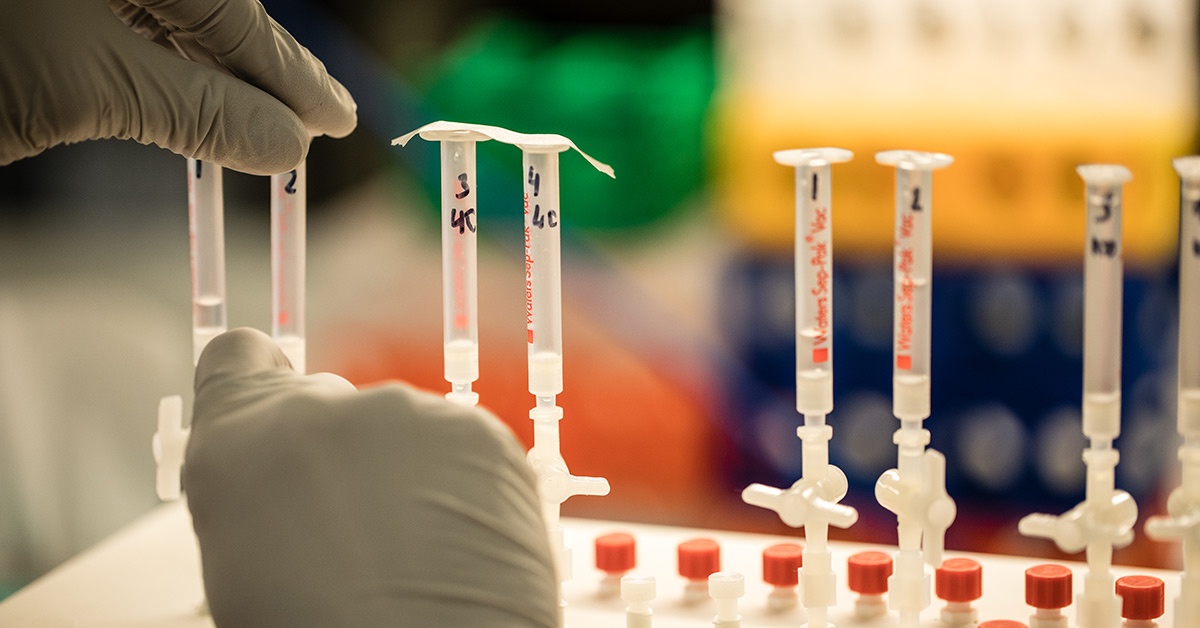As the COVID-19 pandemic rages on, billions of people around the world await a safe and effective vaccine, which will be key to ending the crisis. Developing a safe and effective vaccine requires testing it in carefully conducted clinical trials that identify its potential side-effects, determine the correct dosage to use, and calculate how well it protects against disease. The process ensures that approved vaccines are ones that people can trust.

Professor Joseph Koopmeiners is an expert in conducting clinicals trials. Koopmeiners is head of the School of Public Health’s Division of Biostatistics and a researcher for its Coordinating Centers for Biometric Research, one of the world’s premier leaders in running trials for vaccines and treatments.
“Trials are typically conducted in three phases, a process that is essential to ensuring that vaccines and treatments are safe and effective,” says Koopmeiners.
Phase I
The primary goal of Phase I is to determine if the vaccines or treatments are generally safe for people to use. The researchers begin by testing multiple dosages of a vaccine — perhaps four or more — on groups of 20-50 healthy volunteers. The groups are given different doses of the vaccine and monitored for up to two months for the development of any serious and frequent adverse side-effects.
“We choose people who are similar to those who will need the vaccine,” says Koopmeiners. “The idea is the vaccines will be given to the general public, so, we’d want a mix of people who match that profile.”
Any dosages that produce concerning adverse effects are ruled too dangerous and eliminated from future study.
Phase II
In Phase II, researchers continue to monitor the safety of vaccines, and seek to determine if they stimulate the immune system. Typically, multiple vaccine dosages from Phase I are evaluated on roughly 500 people. Phase II takes place over a matter of weeks and researchers look for what are called “surrogate endpoints,” such as detecting if participants develop antibodies against the virus.
“In Phase II, we don’t yet know if the antibodies will actually be protective,” says Koopmeiners. “We’re just looking to see if the vaccine triggered an immune response in the body.”
Based on the results of Phase II, researchers then identify one dosage to advance to Phase III.
Phase III
This is the final phase of the trial and will ultimately determine if a vaccine is safe and effective. Ten of thousands of people of diverse races and from various communities are recruited over months to participate in what is known as a randomized double-blind, placebo-controlled trial. In such trials, participants are randomly sorted into two groups (i.e. randomized): one that will receive the vaccine or one that will be given a placebo (i.e. placebo-controlled). Neither the participants nor the people giving them an injection know if they are receiving the genuine vaccine or a placebo (i.e. double-blind). Only the researchers who are managing the trial know who received the vaccine and who did not. Doing so ensures that participants won’t change their behavior based on whether they receive the vaccine or not, or any other systematic differences that might influence the results.
The large size of the groups also allows researchers to watch for the emergence of any rare side-effects that could develop in just a few people.
Does the vaccine work?
Researchers determine if a vaccine works by comparing how many people from the vaccinated group develop the disease compared to the placebo-controlled group. In the case of COVID-19, how quickly that happens will largely depend on the speed at which the disease continues to spread in communities. If the disease spreads quickly, the determination happens faster and vice versa.
“Obviously, we don’t hope for a higher background rate of infection, meaning lots of people in the community are getting sick around the same time, but it does make the process of determining if a vaccine works go faster,” says Koopmeiners.
Why?
If researchers see that a significant number of people in the placebo group develop disease in a relatively short period of time, but the people who received the vaccine do not also get sick, they could conclude that the vaccine is working.
For example, if researchers observe that 200 people in the placebo group and 40 people from the vaccinated group get infected over the course of three months, they’ll calculate that the vaccine is 80% effective and could result in the trial being stopped and the vaccine approved for use. If, however, early results show that 100 vaccinated people get infected, then the vaccine is initially only 50% effective. The trial will likely continue to see if the percentage changes as time goes on and more people are enrolled in the study or become infected.
Safety and science first
The group overseeing patient safety and determining when to stop a trial is its data and safety monitoring board. This is an independent group of people who review the data and have no vested interest in the trial. The board’s responsibility is to protect the safety of trial participants and ensure that it’s conducted correctly and ethically.
“They’ll review the data at multiple points during the trial, and if at any point they think there is overwhelming evidence that a vaccine is safe and effective, they’ll stop it,” says Koopmeiners. “What they won’t do is let somebody else look at the data and claim that it’s working before there is strong scientific evidence that we have a safe and effective vaccine.”
Speeding up trials during COVID-19
Testing and approving a vaccine usually takes years. To make the process faster during the pandemic, the U.S. Food and Drug Administration (FDA) reduced some of the administrative steps required to start trials and move from phase to phase. Typically, each phase of the trial involves testing, analyzing the results, and then a long period of reporting and discussion with the FDA — perhaps years — before moving on to the next phase.
“In regular trials, a lot of time is spent waiting and doing administrative work in between phases of the study,” say Koopmeiners. “Now, they’ve cut a lot of that time out.”
As with other trials, testing COVID-19 vaccines always starts with the Phase I safety trial. The change is that if a vaccine appears safe in Phase I and shows signs of producing antibodies in Phase II, researchers are allowed to begin Phase III trials before completely wrapping up work in the earlier phases. The practice allows the researchers to quickly — but still safely — advance from phase to phase without the usual delay from administrative steps.
For more information on how School of Public Health experts are responding to the pandemic, visit the COVID-19 information page.

